French Bulldog vs. Pug: A Real-World Look at Their Health, Habits, and Personalities

French Bulldogs and Pugs may look similar at a glance—small, wrinkled, flat-faced, and full of charm. But living with one (or both) shows just how different they really are. From their health quirks to their energy levels and personalities, each breed has its own rhythm.
Whether you’re choosing between the two or just curious about their differences, here’s what you need to know to make the most informed decision.
Health Issues: What to Expect with Each Breed
Both breeds fall into the brachycephalic category, which means they have short muzzles that can lead to breathing issues and heat sensitivity. But the severity of these problems can vary.
French Bulldogs often deal with more serious airway issues. Many owners report needing surgery to open up their nostrils or fix elongated soft palates. Even light exercise in warm weather can cause distress if not carefully monitored.
Pugs, while still prone to snoring and overheating, tend to do better when kept lean and active in short bursts. Many pug parents say that using cooling mats in the summer and limiting activity during hot hours helps a lot.
Personality and Behavior: Silly vs. Chill
Pugs are typically energetic little clowns. They love attention, playtime, and sticking close to their humans. If a pug feels ignored, you might get the “pug pout”—a dramatic sigh or exaggerated flop onto the floor.
French Bulldogs are a little more reserved. They’re affectionate and loyal but often prefer lounging over constant interaction. You’ll get loyalty, but they’re known to be a bit more stubborn during training sessions.
Many pug owners describe their dogs as social shadows, while Frenchie owners say their pups enjoy companionship on their own terms.
Feeding and Daily Care
Feeding both breeds requires consistency and portion control, but they have different tendencies when it comes to food.
Pugs are notoriously food-driven. Many owners mention that their pugs act like every meal is their first. Pre-measuring food and using slow-feeder bowls can prevent rapid weight gain.
French Bulldogs can be picky and more prone to allergies—especially to ingredients like chicken, wheat, or artificial flavors. Diets with fewer ingredients or novel proteins like duck or fish often help reduce flare-ups, according to community feedback.
Exercise and Energy Levels
Don’t expect marathon runners here—but daily movement is still essential.
Pugs thrive on short walks and indoor play. Their energy usually comes in bursts—zoomies, a nap, then more zoomies. They don’t need much space but do love interaction.
Frenchies are built heavier and can tire faster, but they enjoy games like tug or short fetch sessions. They’re also more likely to overheat, so indoor activity and cool environments are key.
Conclusion
While French Bulldogs and Pugs share some visual traits, they’re very different when it comes to temperament, health, and everyday care. Pugs are fun-loving, people-focused, and thrive on attention. Frenchies bring calm energy, a bit of independence, and their own brand of stubborn charm.
Both breeds have their joys and challenges. What matters most is finding the one that fits best with your lifestyle, your space, and your daily routine.
Related Articles You Might Find Helpful
If you’re still deciding which breed is right for you, check out these articles for more insights:






